Aesopica
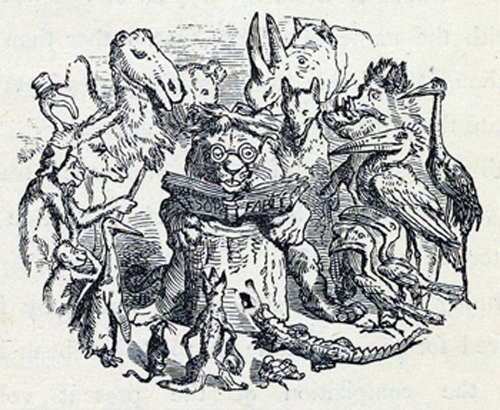
Ernest Griset. "Lion reading to the Animals," 1869.
Aesop's name is magnetic, attracting scores of fables written by others. "The City Mouse and Country Mouse" comes from Horace (65-8 BCE), "The Cock and the Pearl" from Phaedrus (early first century CE), "The Dancing Camel" from Babrius (late first century CE), "Androcles and the Lion" from Aulus Gellius (ca. 125-180 CE), and "Belling the Cat" (also known as "The Mice in Council") from Odo of Cheriton (thirteenth century).
Ever since Phaedrus, fable collections have included fables in which Aesop appears as a character.
Diogenes Laertius (third century CE) reports that Demetrius of Phaleron, working in the Library of Alexandria, assembled a collection of Aesop's fables in the early third century BCE. No copies of that collection survive, but it is presumed to be the source for the core of fables that were adapted and preserved in later collections.
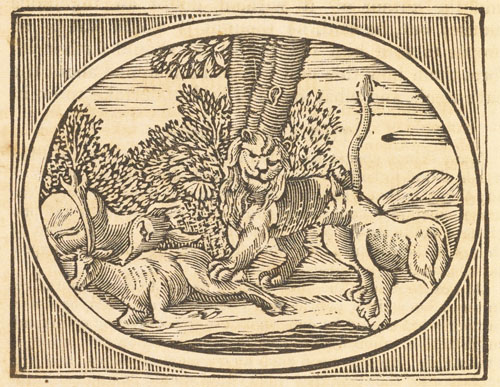
Samuel Croxall. Fables of Aesop
and Others. "The Lion, The Ass,
and the Fox," (London: 1760).
Both Babrius and Phaedrus, for instance, tell versions of the same fables, e.g., "The Wolf and the Dog" and "The Countryman and the Snake." Many have followed their example, including Marie de France (late twelfth century), Martin Luther (1483-1546), and most spectacularly, Jean de La Fontaine (1621-1695), who wrote ten books of fables in verse, dozens of them adaptations of Aesop.
Told and retold through the ages, there are no such things as "authentic" versions of the fables and there is no fixed order. Modern editors freely rearrange them, embellish and sanitize them, or distribute and condense them to make room for illustrations. In their many variations they are called "Aesopica."
Later editors have accepted some traditions. "The Cock and the Pearl" is the first fable in many collections, soon followed by "The Wolf and the Lamb." Fables of the lion in strength and in weakness tend to be put near each other, as in Croxall's Aesop's Fables (1722).
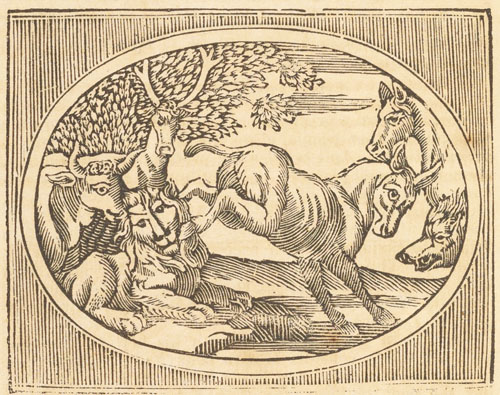
Samuel Croxall. Fables of Aesop
and Others. "The Old Lion," (London: 1760).
In "The Lion, The Ass, and the Fox" (above) the three go hunting, agreeing to share the catch. They kill a deer and the lion asks the ass to divide it. The donkey divides the meat into three equal parts. The lion kills him, then asks the fox to divide the deer. The fox puts almost all of the meat in one pile for the lion, keeping only scraps for himself. The lion approves and the fox survives. From this fable comes the adage, "the lion's share," a phrase often used as the fable's title.
In "The Old Lion" (shown right) by contrast, animals that have been tyrannized by a lion come to him when he is old and infirm and inflict their revenge. Last to come is the ass, who kicks the lion in the head.
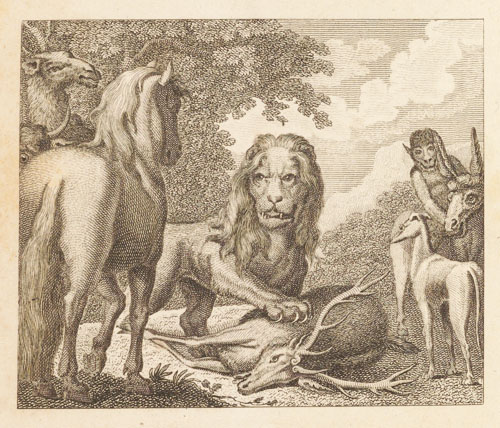
John Stockdale. Fables of Aesop. (London: 1793).
To better sort out the history of Aesopica, Benjamin Perry of the University of Illinois labored to find, edit, and publish the earliest surviving forms. The oldest extant manuscript of fables ascribed to Aesop is the Collectio Augustana from the eleventh century, which contains 231 fables, now at the Bavarian State Library.
The most widely read collection was the Aesopi Phrygii, based on the "Accursiana" recension established by Planudes, with 127 fables. It was first published in Milan in 1474, with a retelling of the life of Aesop attached. Seeing that the collection was an ideal text for students wishing to step from Latin to Greek, the friend and favorite printer of Erasmus, Johann Froben, printed an edition of Aesopi Phrygii in 1513 in Basel with another version of the Life. Aesopi Phrygii went through multiple printings and was pirated and reprinted by other European printers for the next three hundred years.
It is characteristic of Aesopica that they instruct, and many versions add explicit morals to be sure that readers or listeners get the point. As fables moved and altered, so did the morals, some dramatically.
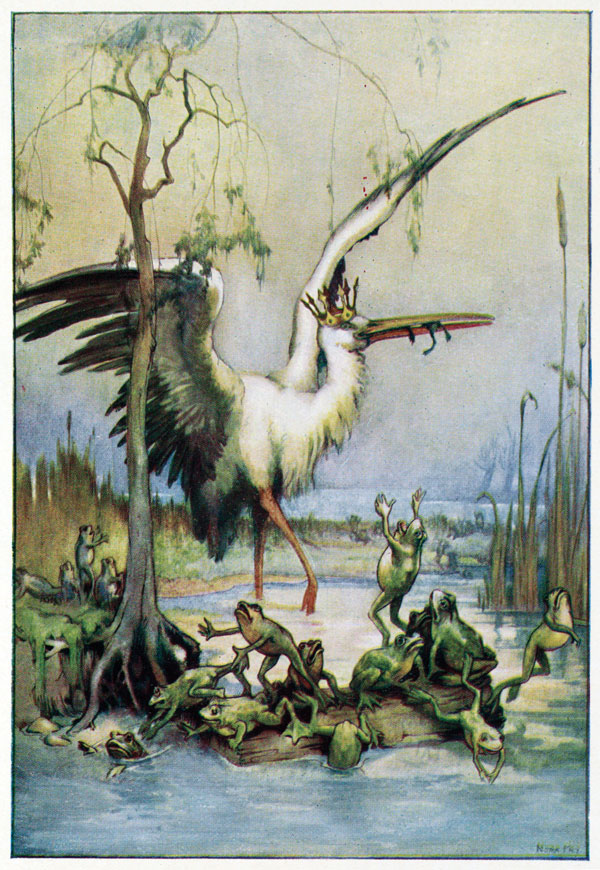
Nora Fry. "The Frogs Desiring a King," 1929.
For example, "The Cock and the Pearl." A cock, scratching for food in a barnyard, finds a pearl. He looks at it and tosses it away. In some books the moral commends the cock for recognizing the vanity of ornament, especially if you're hungry. In some, the moral scolds the bird for its blindness to value. Phaedrus writes, "This is a story I tell for people who do not know how to appreciate me."
Morals matter to parents who want their children to learn the right lesson. In "The Fox and Crow," a fox flatters a crow, who drops its food, which the fox carries away. The moral is "Beware flatterers." But Jean-Jacques Rousseau saw that it also taught the rewards of flattery, and that was what children learned no matter what moral was tagged on.
Planudes's Life depicted Aesop telling fables to adults, always adults. Since then, the fables have been made into school books and books for early readers. Fable after fable emphasizes the danger of contact with the powerful. In his legendary Life, Aesop was executed. Versions of "The Lion's Share" appear in almost all collections. By 1722, when the Reverend Samuel Croxall published his enormously successful Fables of Aesop and Others, the Life was dismissed as "monastic waggery" and the fables were shaped and chosen to teach English children. Aesop, the slave striving for freedom, became an advocate of the status quo.

Harrison Weir. "The Eagle and the Fox," 1867.
Croxall pointed to the fable, "The Frogs Desiring a King" (shown above). The frogs pray to Jupiter for a king, and wise Jupiter answers their prayers, giving them a log that lies in the water, doing nothing. The frogs complain they want a live and active king, so Jupiter gives them a stork, who eats them. To make such a tale fit for English children, Croxall adds a moral from Phaedrus: "Be contented with your present condition, bad as it is, for fear a change would be for the worse."
Fables often end with killing. Sheep and deer are slaughtered, poisonous snakes bite benefactors, lions prey on bulls, hawks prey on smaller birds, and animals fight wars. Some books of Aesop's fables for children tone down the violence, or remove some of it; other books emphasize and illustrate it—the fable of the "The Eagle and the Fox," for example.
A mother eagle and a mother fox agreed they would live together and protect each other's children; the eagle from her nest above, the fox from her burrow below. One day while the fox was out hunting, the eagle decided to feed the fox cubs to her eaglets. When the fox returned and saw the treachery, she set fire to the tree, roasting the eaglets. When they fell to the ground she ate them.
In some versions the fox arrives before her cubs are eaten, and by threatening to burn the tree, she gets them back safe and sound. In some versions, the fox obtains fire from a shrine, suggesting that her vengeance is sanctified. In all versions the fable turns on the tension between the two mothers and what they will do for their offspring.
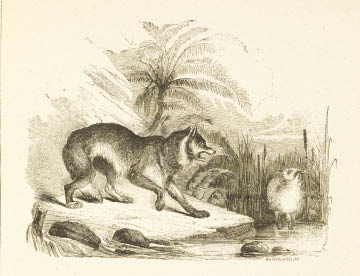
John Tenniel. "The Wolf and the Lamb," 1884.
Parents teach Aesop to children because the fables feature parents and children. In "The Thief and His Mother" a boy steals things for his mother, who thanks him for it. When he is caught and led off to be executed, he asks her to come close for a final kiss, then bites her ear off. In "The Monkey and Her Two Children" a mother monkey loves one child to death, while the one left to run wild survives. In "The Father, the Son, and the Lion" an overly protective father tries to shield his son from every danger. The son sees a painting of a lion and is scared to death. The world of Aesop is a cruel and frightening world.
One of the first fables found in early collections is "The Wolf and the Lamb." A wolf sees a lamb and explains why he has good reason to kill it. The lamb defends itself, and for every reason the wolf proposes, the sheep has a rebuttal. At last the wolf gives up justifying and eats the lamb anyway.

Ernest Griset. "The Grasshopper and the Ant," 1869.
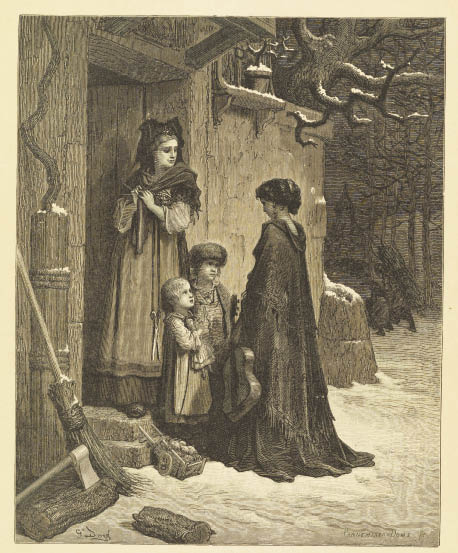
Gustave Doré. "The Grasshopper and the Ant," 1867.
"The Grasshopper and the Ant," is a very well known fable and appears in almost all Aesop collections. In summer ease the grasshopper plays and sings while the ant works all day preparing for winter. When winter comes, the grasshopper begs for food, but rather than food the ant gives him a scolding. We may suppose the grasshopper starves to death.
The fable is a favorite for illustrators. Two examples are shown here, one by Ernest Griset, whose grasshopper carries a guitar, and the other by Gustave Doré, who drops the animal artifice altogether, and applies the fable to two women, one a mother guarding the door of her home, the other with only a guitar. Aesop's fables are unkind to musicians, philosophers, and prophets.
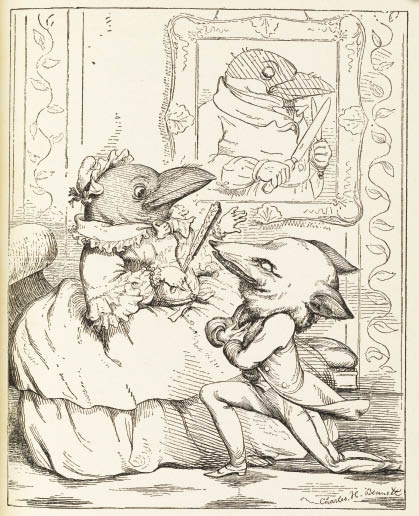
Charles H. Bennett. "The Fox and the Crow," 1857.
The "Fables" are also unkind to women. In Planudes's Life, ugly Aesop has insulting things to say about women. Aesop never marries, and he mocks hen-pecked husbands. Illustrators imposed gender.
Charles Bennett's "The Fox and the Crow" shows the crow as a full-figured woman in dress and bonnet and the flattering fox as a sly-eyed gallant. There is no reason that either the ant or the grasshopper should be female, but Doré chose to make them so.
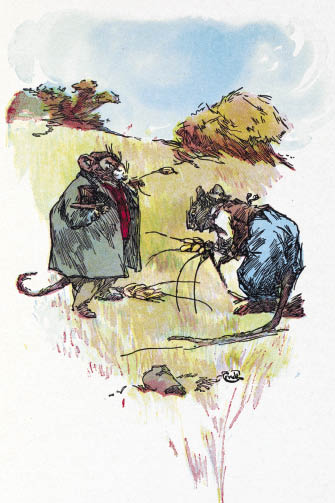
J.M. Condé. "Country Mouse and the
City Mouse," 1913.
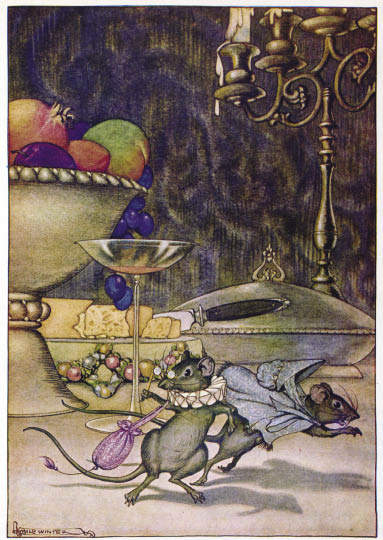
Milo Winter. "Country Mouse and the
City Mouse," 1919.
By the turn of the century the developing market for children's books attracted talented illustrators to Aesop. Some, like J. M. Condé, Arthur Rackham, and Edmund Detmold, were particularly eager to show animals drawn from life, though Condé and Rackham found it prudent to give mice overcoats. Gustave Doré, Nora Fry, and Milo Winter preferred scenes of dénouements, the more dramatic the better.
There are now Aesops online, in Braille and shorthand, in collectors' editions, and in comic books. There is an Aesop for everyone.
proceed to exhibition list

